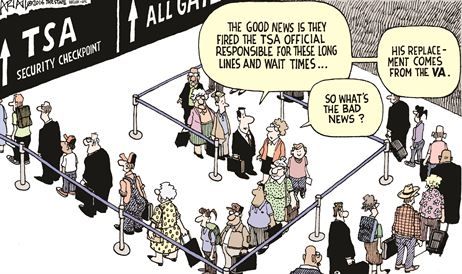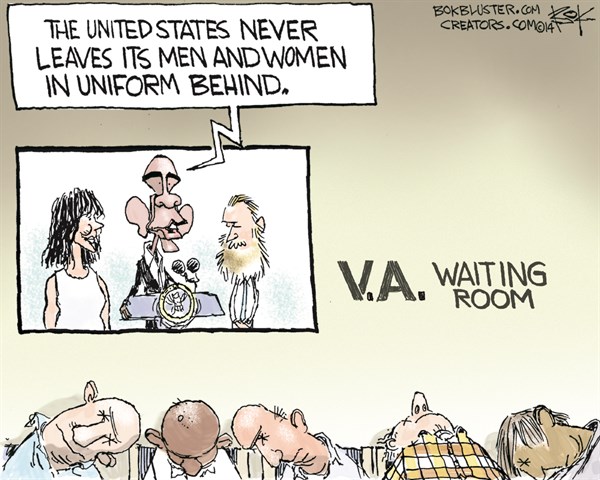
Tag: VA
Government Can’t Help; It Can Only Hurt

Three recent stories regarding three government agencies — the IRS, the Transportation Security Administration (TSA), and the Department of Veterans Affairs (VA) — show why we should oppose big government for practical, as well as philosophical, reasons.
In recent months, many Americans have missed their flights because of longer-than-usual TSA security lines. In typical DC fashion, the TSA claims the delays are because of budget cuts, even though Congress regularly increases the TSA’s funding!
The TSA is also blaming the delays on the fact that few Americans have signed up for its “PreCheck” program. Under PreCheck, the TSA considers excusing some Americans from some of the screening process. Those who wish to be considered must first submit personal information to the TSA and pay a fee. Only a bureaucrat would think Americans would be eager to give the TSA more information and money on the chance that they may be approved for PreCheck.
The TSA is much better at harassing airline passengers than at providing security. TSA agents regularly fail to catch weapons hidden by federal agents testing the screening process. Sadly, Congress will likely reward the TSA’s failures with continued funding increases. Rewarding the TSA’s incompetence shouldn’t surprise us since the TSA owes its existence to the failure of government to protect airline passengers on 9/11.
VA hospitals fund solar panels while veterans die waiting for doctors
Via Doug Ross
By Bre Payton and Tori Richards
Veterans Administration hospitals have spent at least $420 million on solar panels and windmills while vets wait months — or even lay dying — to see a doctor.
In total, VA hospitals reported 23 deaths due to 76 instances of delayed care, an April 2014 VA fact sheet said. Then on June 5, Acting Veteran Affairs Secretary Sloan Gibson revealed that at least 18 Phoenix patients died while waiting for treatment on a secret list kept off the books. It is not clear if that number is in addition to the 23 deaths reported earlier. During the past month, the scandal has resulted in the resignations of both the VA secretary and the leaders of its health care component.
According to a June 3 audit, 100,000 veterans had lengthy wait times for appointments. Of the nation’s 216 VA hospitals, 37 percent will require further investigation.
A whistleblower revealed Tuesday that seven of the patients listed on the Phoenix VA hospitals waiting list are already dead. That same Phoenix facility spent $20 million to build the nation’s largest solar carport. Phase one of the project was completed in 2011. The hospital also had an $11.4 million shortfall that year, an Inspector General’s report stated.
Also in 2011, only 49 percent of first-time patients nationwide got a full mental health evaluation within the VA’s own goal of within 14 days after initial contact, the IG’s report said.
The Phoenix hospital is not the only VA hospital to have installed solar panels while hiding long wait times. Millions in stimulus funds were used to install panels on two facilities, one Albuquerque, N.M., and another in nearby Tucson, Ariz.. With the latter, the VA spent $14.7 million between 2010 and 2012 to install solar panels on the roof of its medical center. The contract was awarded to REC Solar, the sixth-largest recipient of stimulus funds from the VA.
During the time of the solar project, one patient at the Tucson, Ariz., hospital died of colon cancer after not getting a routine colonoscopy. That death was revealed in a fact sheet the VA released in early April after an internal investigation.
Ironically, Rep. Raúl M. Grijalva, D-Ariz., recently praised the Tucson hospital for its “exemplary services.” The Inspector General’s report gave the hospital three out of five stars for performance in 2013 while the Phoenix facility earned just one star.
Even though the epicenter of the scandal remains in Phoenix, Albuquerque, N.M., has come under fire recently for falsely stating wait times and manipulating statistics to receive bonuses.
A 2012 audit by the VA’s Southwest Health Care Network revealed that VA administrators have known about the fabricated reports for two years. That audit went public only after the Arizona Republic received the document in response to a Freedom of Information Act request.
During the time the VA was made aware that wait times were being falsified, it was spending nearly $15 million to fund solar panels for the hospital.
Contact Bre Payton at [email protected], or follow her on twitter @bre_payton. Contact Tori Richards at [email protected] and on twitter @newswriter2.
AMNESTY CAN’T WAIT

OBAMA LEAVES NO ONE BEHIND
Professor Krugman Nails It Again: VA “Is Huge Policy Success Story Which Offers Important Lessons For Future Health Reform”
Somebody give this guy another Nobel. His brilliance is breathtaking to behold.

From David Stockman
Presented without comment because Krugman speaks best for himself!
Here is Paul Krugman, writing in 2006:
American health care is desperately in need of reform. But what form should change take? Are there any useful examples we can turn to for guidance?
Well, I know about a health care system that has been highly successful in containing costs, yet provides excellent care. And the story of this system’s success provides a helpful corrective to anti-government ideology. For the government doesn’t just pay the bills in this system — it runs the hospitals and clinics.
No, I’m not talking about some faraway country. The system in question is our very own Veterans Health Administration, whose success story is one of the best-kept secrets in the American policy debate.
Here is Krugman again, in 2011:
What Mr. Romney and everyone else should know is that the [Veterans Health Administration] is a huge policy success story, which offers important lessons for future health reform. And yes, this is “socialized medicine” — although some private systems, like Kaiser Permanente, share many of the V.H.A.’s virtues. But it works — and suggests what it will take to solve the troubles of U.S. health care more broadly.
This argument has been fairly popular in liberal circles for years. Phillip Longman has written extensively about how great the VA healthcare system is and why it should serve as a model for broader healthcare reform.
TIP OF THE ICEBERG

WARFARE STATE WASTE
I rail about the welfare state every day. But the warfare state is just as bad. The government just spent 3 months worth of foodstamps for 47 million people on 10 submarines we absolutely do not need. But the neo-cons have the balls to say we are gutting the military. Maybe some of these billions could be better spent taking care of the injured and dying veterans from the previous wars of choice waged on behalf of the corporate interests. In case you were wondering, this is what Eisenhower was talking about in his military industrial complex speech.
Guest Post by David Stockman
Pouring Keynesian Waste Into Davy Jones’ Locker: Yesterday’s $18 Billion “Upside Surprise”
The algos were raging yesterday morning because April durable goods orders were up by an unexpected 0.8%. Well, yes they were: The US Navy inked a gigantic $18 billion order for 10 new nuclear-powered attack submarines during the month. Consequently, the actual 0.8% decline in industrial orders was transformed into a swell “upside” surprise.

U.S. Navy
U.S. Navy placed a record order in April for killer subs.
But folks, the US Warfare State doesn’t need no more stinking nuclear attack submarines. It already has more than 70 in service, and several more beyond yesterday’s huge order were already in the pipeline.
The reason we don’t need them— beyond the vast redundancy in firepower already extant— is that attack submarines have one primary mission. Namely, to kill nuclear-powered submarines carrying the ICBMs of hostile powers who may have them aimed at US cities.
Here’s the deal. China has just three ICBM capable submarines which have a range under 5,000 miles and which have never been deployed in the blue water; and Russia’s rusting legacy fleet of 10 subs left over from the cold war (that would be the one which ended a quarter century ago) is basically mothballed in port.
During the most recent year, the Russian Navy’s operating tempo was so anemic as to amount to one SSBN submarine on the water at any given time. So even though they theoretically have 160 submarine launched ballistic missiles on their 10 ships compared to 656 for the US, 90% of Russia’s SLBMs could never be launched.
Stated differently, during the peak of the cold-war in 1983, the Soviet Navy conducted 105 patrols compared to 5 in 2012. Yet back then we have far fewer attack subs on the water and what we had were far less lethal than today’s US fleet. Stated differently, the 70 attack subs we already have are advanced technology killers purchased at the peak of the Reagan build-up— and at a time after the current Russian fleet of aging SSBNs were already on the water!
Since the strategic nuclear stand-off ended decades ago, the attack submarine fleet has been given an additional mission to serve as a deterrent against surface ships and especially aircraft carrier battle groups of hostile industrial powers. Needless to say, China has one re-conditioned nuclear aircraft carrier it bought second-hand from the Ukraine! And Russia has one, and yes, it too patrols the languid waters of its homeport.
So the 10 new attack submarine order announced yesterday is just mindless waste. The order amounts to a preposterous exercise in military Keynesianism that adds nothing to the security and safety of the American people, but will result in the drastic waste of fiscal resources in a nation that is already drifting rapidly toward insolvency.
This modern day exercises in sub-sea pyramid building, however, does smoke out the abysmal economic ignorance of the so-called financial press. The writer of the story below, one Jeffry Bartash, had no trouble with the idea that pouring steel and electronics into Davy Jones’ locker was a sign that the American economy is coming back to life.
By Jeffry Bartash at Market Watch
U.S. nuclear subs surfaced in a big way in the April durable-goods report. A record Navy construction contract powered a 0.8% gain in durable-goods orders last month when Wall Street was actually expecting a 0.8% drop.
In April, the Navy inked a $17.6 billion contract for 10 nuclear-powered attack submarines. Contractors General Dynamics Electric Boat and Huntington Ingalls Newport News Shipbuilding will handle construction. The deal could reach as high as $17.8 billion under certain conditions.
The huge contract led to a 39% increase in defense orders in April, using seasonally adjusted numbers. Orders for defense capital goods rose to $12.89 billion from $9.3 billion in March and $7.8 billion in February.
Of course, the subs won’t all be built right away, so the benefits to the economy will be spread out over the next five years.
The boom in demand for military equipment spruced up an otherwise drab durable-goods report. Booking for big-ticket U.S. goods actually fell in April if defense is excluded. Orders often fall in the first month of a new quarter….
Click here for complete article:
– Jeffry Bartash




